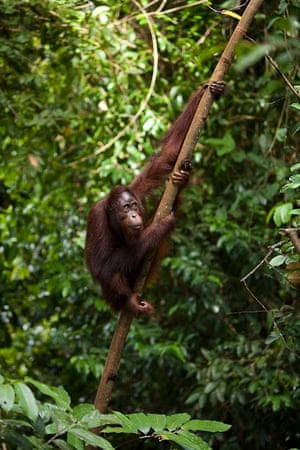Orangotango macho, Bornéu
Semenggok Forest Reserve Sarawak
BorneoMalaysia
créditos: Eleifert/Wiki Commons
O abate de árvores e as plantações à escala industrial nas florestas tropicais do Bornéu causaram o desaparecimento de 100.000 Orangotangos entre 1999 e 2015, alerta um novo estudo científico internacional.
O número é o resultado de 16 anos de trabalho de uma equipa internacional para saber o que está a acontecer ao Orangotango (Pongo pygmaeus), espécie ameaçada pela exploração mineira e pela indústria do óleo de palma, madeireira e de pasta de papel.
Orangotango de Bornéu (Pongo pygmaeus)
créditos: Eleifert
A situação crítica desta espécie levou a que, recentemente, mudasse de estatuto, passando a ser classificada Lista Vermelha da União Internacional para a Conservação da Natureza (UICN), como Criticamente Em Perigo de extinção.
“O uso insustentável dos recursos naturais causou um declínio dramático dos Orangotangos do Bornéu”, (...) “Apenas 38 das 64 metapopulações que restam têm mais de 100 indivíduos.”
Investigadores, artigo, revista Current Biology
As ameaças são várias. Só a desflorestação, por exemplo para criar espaço para as plantações de óleo de palma, pode dizimar mais 45.300 Orangotangos nos próximos 35 anos, estimam os investigadores.
E depois, muitos animais vivem em populações pequenas e fragmentadas. “Estas não são viáveis e muito provavelmente vão desaparecer num futuro próximo.”
Os cientistas descobriram que os animais também estavam a desaparecer nas áreas ainda com floresta.
Orangotango de Bornéu
créditos: Marc Ancrenaz
A causa? Segundo a investigadora Maria Voigt, do Max Planck Institute for Evolutionary Anthropology (Alemanha). muitos Orangotangos estão a ser chacinados como retaliação por danos nas culturas.
O estudo refere que na região de Kalimantan morrem em média 2.256 Orangotangos por ano, devido a conflitos com as populações.
“Isto é chocante e desnecessário. Os Orangotangos podem comer os frutos dos agricultores mas não são perigosos”.
Serge Wich
Segundo os investigadores, “parcerias eficazes com empresas madeireiras, cujas propriedades albergam a maioria dos orangotangos, são essenciais para travar o declínio destes animais”.
Female orangutans and her young
credits: Marc Ancrenaz
Female orangutans are occasionally killed for their young, which are sold on as pets, while others are killed for food or for venturing onto plantations or into gardens.
Hunting and killing have driven a dramatic decline in the orangutan population on Borneo where nearly 150,000 animals have been lost from the island’s forests in 16 years, conservationists warn.
Orangutan in Borneo
credits: Marc Ancrenaz
Researchers estimate that the number of orangutans left on Borneo now stands at between 70,000 and 100,000, meaning the population more than halved over the study period which ran from 1999 to 2015.
While the steepest percentage losses occurred in regions where the forest has been cut down to make way for palm oil and acacia plantations, more animals were killed by hunters who ventured into the forest, or by farm workers when the apes encroached on agricultural land, a study found.
“We need to work with people to help them understand that orangutans are not dangerous and that it’s illegal to kill them,” Wich said. One approach that might work, he said, is to have Indonesian and Malaysian role models raise awareness of orangutans through social media.
Orangutang babies rescued
credits: Caters
The super-cute snaps were captured by International Animal Rescue staff at their rehabilitation centre in Ketapang, West Kalimantan, in the Indonesian part of Borneo.
The youngsters - many of whom grew up in captivity as pets before being rescued - are being taught to climb, play and fend for themselves
The Mirror
Without fresh efforts to protect the animals, the numbers could fall at least another 45,000 in the next 35 years, the conservationists predict. The real decline could be worse, because the prediction is based only on habitat loss, and does not include killings.
The bleak assessment of the state of the Bornean apes comes from an international team of conservationists who compiled one of the most comprehensive reports yet on the animals, which in 2016 were declared “critically endangered” by the International Union for Conservation of Nature (IUCN)/ RED List . Read more here
Geração 'green'
4.03.2018
Geração 'green'
4.03.2018







No comments:
Post a Comment